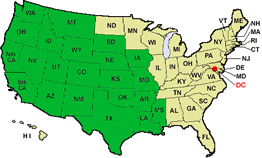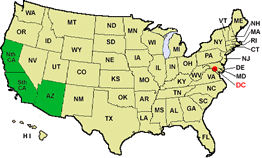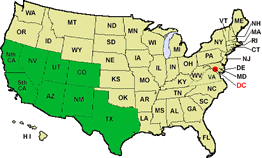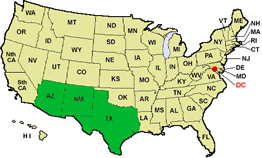| About Termites |
| Termite Control |
| Exterra |
| Sentricon |
| Pest Control |
| Spider Identification |
| Consumer Advice |
| Links / Resources |
| Home |
| Destructive Termites in Arizona |
| Identification of the main destructive species |
| It is critical to identify the species of destructive termites to formulate
an appropriate control program. The main species of destructive
termites in Arizona are: CONTENTS: learn about destructive species of termites - tips on identification of the timber damage - find out when they swarm in your local area and how to identify the swarmers, workers and soldiers - learn about their fascinating biology, life-cycle and behavioural aspects - and receive professional tips on how best to protect your home from the world's best timber recycler .... subterranean termites. |
| Arid-land subterranean termites |
Identification of Swarmers and Soldiers: In locations below 4,000 feet the Arid-land termite swarms between January and March. Above 4,000 feet, they usually swarm in June and July. The swarmers are about 1/3” long with wings, and 1/5” long without wings. Their wings are almost whitish, with brown veins in the fore area. Swarmers are dark brown to black in color. The soldiers are 1/4” long, with jaws that are nearly straight. They resemble the jaws of the desert termite but are slightly thicker. Biology and Habits: The Arid-land subterranean termite has been found living in sand dunes, as well as at altitudes above 7,000 feet in the Rocky Mountain states. It is also found in moist river low lands and along streams and canyons, but essentially it is a desert or prairie species. Arid-land subterranean termites naturally occur in deserts where they attack creosote and greasewood bushes as well as buildings and other timber structures. |
| Desert subterranean termites |
The Desert subterranean termite is one of the most common subterranean termites in Arizona, Colorado and California. The Desert subterranean termite lives in desert plants including dead cactus, but can severely damage structural timbers in buildings, utility poles and other timber structures. Identification of Swarmers and Soldiers: The Desert subterranean termite swarmers are about 3/8" long including their wings. Their body is a pale yellowish brown and a fontanelle (front gland pore) is indistinct or absent. The wings have two prominent hardened veins in the front portion. The wing membrane is translucent, almost colorless, with a few barely visible hairs. The front wing is larger than the hind wing. The head of the Desert subterranean termite soldier is rectangular in shape, the length about twice the width. It also has a fontanelle (front gland pore) on the forehead. The body (pronotum) is flat and almost as wide as the head. The Desert subterranean termite soldiers have long powerful pointed jaws (mandibles) that are slender, fairly straight but slightly curved inward at the tip. This contrasts with the mandibles of the Western subterranean termite that are thick and curved. The small size of Desert subterranean termites and their ability to forage under dry conditions allows them to occupy a niche not exploited by other subterranean termite species. Identification of Timber Damage: Desert subterranean termites prefer to eat the springwood in timbers, generally avoiding the lignin in summerwood. Damaged timber appears honeycombed, with soil in the galleries. The Desert subterranean termite is less dependent on moisture and decay than other subterranean termites. It will readily attack dry, sound wood. A typical sign of infestation is the presence of “drop tubes” coming from the ceiling rafters and sheetrock/plasterboard and/or holes in the sheetrock plugged with faeces. Identification of Mud-shelter Tubes: Desert subterranean termites prefer to forage in shaded soil or areas made wet by irrigation. They will readily construct mud shelter tubes up, over or around solid objects in order to reach a timber food source. These mud-tubes are slender, solidly built and pale yellow to tan in color. The mud-tubes are more circular in cross section than those of the Western subterranean termite whose mud-tubes are flattened in cross section and dirty light brown in color. Biology and Habits: Desert subterranean termites most often swarm at night during the rainy season, from July to September, usually after rainfalls. The moist soil provides the nuptial Desert subterranean termite swarmers with the best chance of surviving and developing a new colony. The male and female pair off and enter the soil where they excavate a cavity or cell. A well-developed mature colony of Desert subterranean termites may contain more than 300,000 termites, including a large number of secondary reproductives (queens) that can readily break off from the primary colony to form separate colonies. Desert subterranean termites commonly have a foraging territory of up to almost an acre. Desert subterranean termites require only a tiny gap, about 1/32", in concrete flooring or mortar joints in brick walls to gain access to the wall, roofing and other structural timbers in a building. The Desert subterranean termite can penetrate cracks in concrete and masonry that are too narrow for foragers of other subterranean termite species to enter. Desert subterranean termites often build their mud-shelter tubes as free standing tubes that "drop down" from rafters, ceilings and subfloor areas under buildings. |
The Western drywood termite accounts for most of the drywood termite damage in Arizona, California, Colorado, Texas, Utah and Virginia. Colonies contain up to about 2,000 termites. Severe damage may be caused by the presence of multiple-colonies.It is easily transported outside these areas in infested furniture and other timbers. This termite lives in timber with moisture content of less than 12%. Drywood termites are often distributed by human activity, commonly by transporting infested furniture, picture frames, and wood to new areas. It has failed to become established in such areas outside its normal southern and mostly coastal range. Identification of Swarmers and Soldiers: Swarmers are about 1/2" long including wings Their wings are 3/8" long. The head and pronotum of the swarmer is an orange brown and its abdomen is dark brown. The front wing has 3 dark, heavily hardened veins in the front portion. The forehead of the soldier slopes down gradually from top of head, head flattened to slightly rounded in side view, and head orange to reddish brown with the eye spot whitish. Soldiers have mandibles with unequal number of teeth on each member of pair, and antenna with the third segment greatly enlarged and club-like. Identification of Timber Damage: Although the colony development is slow, severe structural damage may still be caused by the presence of multiple-colonies. Drywood termites eat across the wood grain and create chambers, or galleries connected by tunnels. Their gallery and tunnel walls are velvety smooth, and no soil is present. Generally, there are faecal pellets present. They are hard, less than 1/32" long, elongate-oval with rounded ends. One of the unusual distinctive signs of their faecal pellets is that they have 6 concave sides. Evidence of infestation include swarmers, shed wings, piles of pellets, termite plugs that seal all openings in infested wood, and surface blisters caused by older, enlarged galleries very close to the wood surface. Biology and Habits: Drywood termites are considered non-subterranean termites, as they do not live in the ground, require no ground contact, and do not build mud shelter tubes. They are more likely to be in a structure made completely of wood with poor workmanship demonstrated by poorly fitted corner joints. The termites typically inter the ends of wood and seldom enter the sides of the section in question. Their colonies are located in the wood they eat and are generally small in size when compared to subterranean termite colonies. The colony usually numbers about 3,000 individuals after over 10 to15 years. A distinctive indication is no presence of a worker caste and the nymphs perform all tasks typically done by workers. After the mating flight, they seek cracks or knotholes in nearby wood and chew a small tunnel which they close then excavating a chamber after which they mate. After 3 year to 4 years the colony may consist of up to 1,000 members. The first swarmers may be released when the colony is approximately 4 years old. Swarming typically takes place about midday on sunny, warm (80°F) days, with the peak of the swarm occurring shortly after a sudden rise in temperature. It typically occurs during September and October. Swarmers usually number in the dozens, occasionally the hundreds. Night swarmers are attracted to lights. Swarming drywood termites fly into structures and infest wood directly. When swarming, they often reinfest the same structure. They typically first infest exposed wood such as window/door frames, trim, eaves and attics. They do so by finding a protected crevice or other area, such as the joint between 2 pieces of wood, where shingles/paper overhang timber or moulding, etc., and then attack the wood. |
| Desert Dampwood termites |
Identification of Swarmers and Soldiers: The swarmers of this species are dark brown, swarming during the daytime. Identification of Timber Damage: This species infests wood at or below ground level in the southwestern United States. It sometimes girdles young citrus trees and grapevines below the soil line in desert areas. In the southwest it attacks living trees and bushes and is a problem for citrus groves. Is a pest of timbers in service, infesting moist timbers that are in contact with he soil. Untreated posts, poles, and fences are attacked below ground level. Biology and Habits: This species does not build mud shelter tubes above the ground in order to reach wood. This is an unusual dampwood termite in several respects. The colonies extend from the wood into the soil, they sometimes kill living shrubs and trees, frass is cone-shaped rather than cylindrical, and the termites have a pungent odour. They also have directed trail-following behaviour, unlike other dampwood termites. |
| Learn about professional Termite Control ...Click on Termite Control |










| |
| Published by Fumapest Group © copyright 1995 - |



